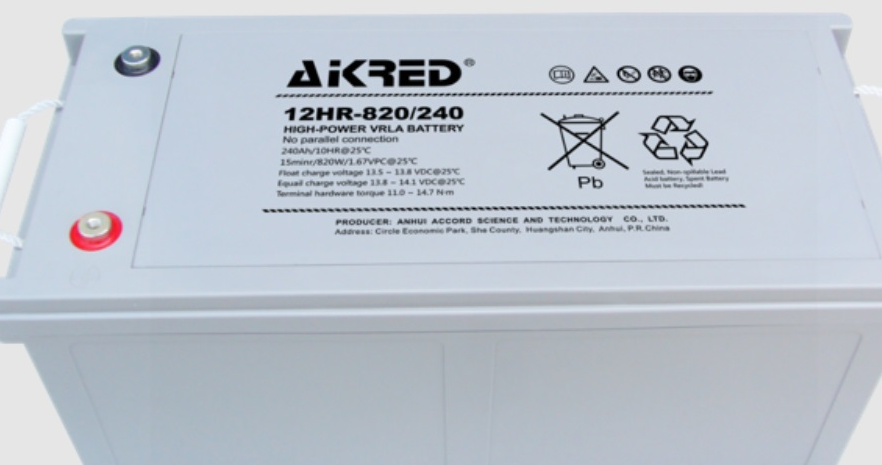Lead-acid battery (VRLA) is a kind of battery whose electrodes are mainly made of lead and its oxides, and the electrolyte is sulfuric acid solution. In the discharged state of a lead-acid battery, the main component of the positive electrode is lead dioxide and the main component of the negative electrode is lead; in the charged state, the main component of both the positive and negative electrodes is lead sulfate. The nominal voltage of a single cell lead-acid battery is 2.0V, can be discharged to 1.5V, can be recharged to 2.4V; in the application, often with six single-cell lead-acid batteries in series to form a nominal 12V lead-acid batteries, as well as 24V, 36V, 48V and so on.
The electrochemical reaction formula of a valve-regulated lead-acid battery is shown below. Charging is charging by connecting an external DC power source to the battery so that electrical energy is converted to chemical energy and stored. Discharging is the release of electrical energy from the battery to drive external equipment.
When the VRLA battery charging will reach the peak, the charging current is only used to decompose the water in the electrolyte, at this time, the battery positive electrode produces oxygen, the negative electrode produces hydrogen, the gas will be overflowed from the battery, resulting in a reduction of electrolyte, the need to add water from time to time.
On the other hand, at the end of charging or overcharging conditions, charging energy is used to decompose water, the oxygen produced at the positive electrode reacts with the spongy lead at the negative electrode, which puts a part of the negative electrode in an unfilled state and inhibits the production of hydrogen at the negative electrode.
Lead-acid batteries for car starting is something that we often use in our daily life, sometimes there will be a case of not being able to start the fire, go to the repair point goods 4S store, they usually recommend that you replace the new one, in fact, it is not necessary.
1. First of all, you have to check the battery's "electric eye" according to the description of the electric eye to determine the good and bad, generally speaking, green is good, red is bad, white or black is the need for charging or add electrolyte, this specifically depends on the electric eye of the density of the ball what color, the instructions are generally written.
2. Next is the battery charging, general one-time charging about 8 hours can be restored to the new battery capacity of about 80%, you can continue to use.
3. After charging, you can't start the fire, we need to use the detector, general discharge state continuous discharge 5-seconds if the discharge voltage is less than 8 volts, it means that the battery has a problem, because you are just charging the battery, there is no loss of power.
4. Next, use a discharge meter to continue monitoring, open the single cell of the battery, press the discharge button, if any single cell appears continuous bubbles, then that single cell is damaged, record it.
5. Then use the density meter to test the density of each single cell, if the density of any single cell with the other single cell difference is large, then the single cell is damaged, both cases have to replace the single cell processing.
Replacement of single cell requires professional operation, if you are not a professional, it is recommended that you replace the battery, or ask a professional to repair.

(1) Use tools with insulating sleeves such as pliers. The use of non-insulated tools will cause short-circuiting, heating or burning and damage the battery.
(2) Do not place the battery in a closed room or near a source of ignition, as it may explode or catch fire due to hydrogen gas released from the battery.
(3) Do not use thinner, gasoline, kerosene, or synthetic fluids to clean the battery. Use of these materials can cause the battery case to rupture and leak or catch fire.
(4) When handling batteries with a voltage of 45 volts or higher, take safety precautions and wear insulated rubber gloves, otherwise you may receive an electric shock.
(5) Do not leave the battery where it may be flooded. If the battery is immersed in water, it may burn or cause electric shock.
(6) Handle the battery slowly when removing it. Do not crack or leak the battery.
(7) When installing the battery in the equipment, try to install it at the bottom of the equipment for inspection, maintenance and replacement.
(8) Do not move the battery while it is being charged. Do not underestimate the weight of the battery; careless handling may cause injury to the operator.
(9) Do not cover the battery with materials that generate static electricity. Static electricity can cause a fire or explosion.
(10) Use insulated covers on battery terminals and connecting tabs to prevent injury from electric shock.
(11) Installation and maintenance of the battery needs to be performed by qualified and specialized personnel. Unskilled persons performing that kind of operation may cause danger.